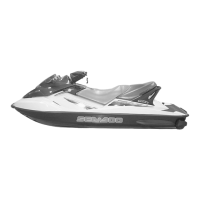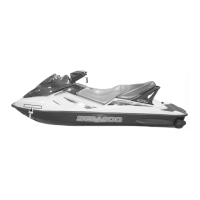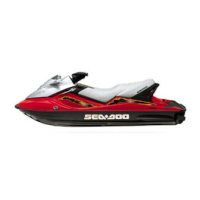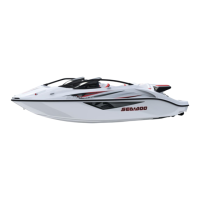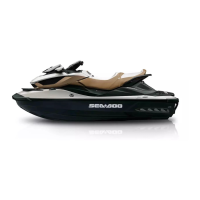Section04ENGINEMANAGEMENT(15034-TEC)
Subsection 03 (COMPONENT INSPECTION, REPLACEMENT AND ADJUSTMENT)
WARNING
Fuel lines remain under pressure at all times.
Always proceed with care and use appro-
priate safety equipment when working on
pressurized fuel system. Wear safety glass-
es. Do not allow fuel to spill on hot engine
parts and/or on electrical connectors. Pro-
ceed with care when removing/installing
high pressure test equipment or discon-
necting fuel line connections. Use the VCK
(Vehicle Communication Kit) to release fuel
pressure prior to removing a hose. Cover
the fuel line connection with an absorbent
shop rag. Slowly disconnect the fuel hose to
minimize spilling. Wipe off any fuel spillage
in the bilge. Fuel is flammable and explosive
under certain conditions. Always work in
a well ventilated area. Always disconnect
battery prior to working on the fuel system.
After performing a pressure test, use the
valve on the fuel pressure gauge to release
the pressure (if so equipped).
Always disconnect battery properly prior to work-
ing on the fuel system. Refer to BATTERY sec-
tion.
When the job is done, ensure that hoses from fuel
railgoingtofuelpumpareproperlysecuredintheir
supports. Then, pressurize the fuel system. Per-
form the high pressure test as explained in this
section and pressurize the fuel separator and fuel
lines as explained in FUEL SYSTEM section.
Properly reconnect the battery.
WARNING
Ensure to verify fuel line connections for
damage and that NO fuel line is disconnect-
ed prior to installing the safety lanyard on
the DESS post. Always perform the high
pressure test if any component has been
removed. A pressure test must be done be-
fore connecting the safety lanyard. The fuel
pump is started each time the safety lanyard
is installed and it builds pressure very quick-
ly.
To check fuel rail for leaks, first pressurize the sys-
tem then spray soapy water on all hose connec-
tions, regulators and injectors. Air bubbles will
show the leaking area. Check also for leaking fuel
or fuel odor.
WARNING
If any gasoline leak and/or odor are present,
do not start the engine. Repair the leak.
WARNING
Never use a hose pincher on high pressure
hoses.
Fuel Rail
Pressure at fuel rail is supplied and controlled by
the fuel pump module. Refer to FUEL separator
AND FUEL PUMP subsection for pressure test.
There is a valve on fuel inlet hose connected to the
fuel rail. This valve is for manufacturing purpose
only.
WARNING
PRESSURIZED FUEL. Do not unscrew protec-
tive cap. Do not operate the watercraft with-
out cap properly installed.
Replacement
Refer to FUEL INJECTOR in this section.
Fuel Pump
Refer to FUEL SYSTEM section.
ELECTRICAL SYSTEM
It is important to check that the following electrical
system components are functioning properly:
– battery
– fuses
– DESS
– ignition (spark)
– ground connections
– wiring connectors.
It is possible that a component seems to operate
in static condition but in fact, it is defective. In
this case, the best way to solve this problem is
to remove the original part and replace it with one
which is in good condition.
108 smr2005-013
